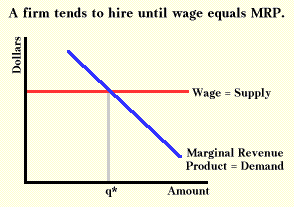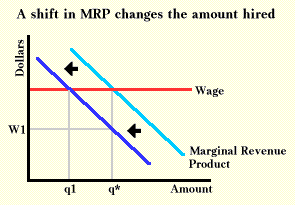Derived Demand
Although economists did not formally develop the ideas of economic aggregation prior to the 1930s, they used them much earlier. An aggregated market that they saw as a problem market during recessions was the market for labor services, or the labor market. On the basis of their understanding of this market, they often suggested that flexibility of prices and wages could cure any fall in output and employment that a drop in total spending might cause. To see why wage flexibility was considered so desirable, we need to explore the idea of derived demand.
A profit-maximizing employer will hire any resource that produces greater value for him than the resource adds in cost. (This is one way of stating the profit-maximizing condition of the firm.) For simplicity we will assume that the added cost equals the wage or price of the resource (which implies that the buyer of the resource is a price taker). The value that the resource contributes depends on two things: how much output increases, and the extra revenue that each unit of the extra output brings to the firm. To recast this idea into the jargon that only economists enjoy, the marginal revenue product (MRP) of the resource should equal the marginal product (MP) of the resource multiplied by the marginal revenue (MR) of output, or in equation form:
(1) MRP = MP x MR.
A numerical example may help clarify the idea involved here. Suppose a firm in the garbage-pick-up industry has a fleet of trucks and must pay workers $10.00 per hour. If the firm receives $1.00 for each pickup, and adding another worker will allow it to make 12 more pickups per hour, is it worthwhile to add another worker? Using the rule discussed above, one sees that the extra value to the firm is 12 x $1.00 or $12.00. The extra cost to the firm of hiring another worker is $10.00. Hence, it is in the interests of the firm to add the extra worker. After this worker is added, the firm may find that adding another worker will add only nine extra pickups an hour. In this case an extra worker is not worth adding because to buy an extra $9.00 of income costs $10.00.
The marginal revenue product of a resource is in fact the firm's demand curve for the resource. Since the law of diminishing returns says that the marginal product of a resource should decline as more and more of the resource is used, (which can justify the drop in garbage pickups from 12 to 9 in the previous paragraph), the demand curve should slope downward to the right. Such a demand curve is shown below. The profit-maximizing amount or labor to hire in this Figure is q*.

Suppose that for some reason people become less willing to buy the product that the firm is producing. This will affect the demand for resources because this demand is derived from the demand for output. In terms of equation 1, the drop in the demand for the product affects the marginal revenue of output. This means that even though the resource is as productive as it was before, it now brings less value to the firm because the output it produces is less valuable. In terms of the graph, the drop in marginal revenue of output shifts the demand for the resource to the left. If the wage does not change, the new equilibrium level of resources hired will be q1 in the graph below, and this will be achieved by laying-off or firing q1-q* of the resources.

However, the resources used by the firm do not need to be reduced if the wage or price of the resources falls. If in the graph the wage falls to W1, the same quantity of the resource will be used as was originally used.1 Thus, if wages or prices of resources are fixed, the amounts used will vary, while if the amounts used are held constant, then wages and prices must be allowed to vary.
The same idea can be seen in our garbage problem. If people suddenly reduce the demand for garbage service, and as a result the firm only gets and extra $.80 for each pickup rather than a $1.00, (notice that this assumes price flexibility), then the extra worker who added 12 pickups will no longer be worth hiring. Hiring him will still cost $10.00, but now this expenditure of $10.00 only brings the firm $9.60 of extra revenue. For the firm to hire the same number of workers, wages must fall (or marginal productivity must rise).
For an individual firm there is no reason to expect the wage to change. The supply curve is horizontal because each firm is competing with many other firms in different industries for workers. However, when markets are aggregated, this role of competition is eliminated. The supply of labor will no longer be horizontal, but should slope sharply upward. When the demand for goods drops, less labor will be demanded at old wage rates. The surplus labor should lead to a drop in wages until unemployment is eliminated. In fact, if wages and prices are perfectly flexible, any drop in spending will cause a drop in prices but no change in output. In such a world output is not determined by aggregate demand, but by technology and resources. There would be no recessions in such a world, only inflations and deflations. However, if wages and prices are not flexible, then a change in total spending will affect output and employment. The pre-Keynesian economists were well aware that wages and prices did not change readily, and considered this inflexibility a major problem.
1 Actually, the condition is a bit stronger. All resource prices must fall, not just that of labor. The prices of other resources are determinants of the demand curve of any resource.
Copyright Robert Schenk